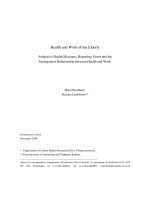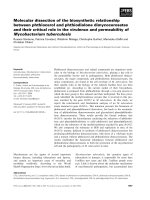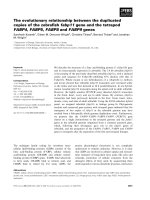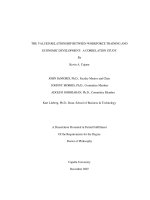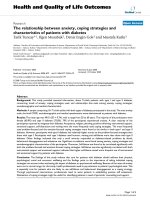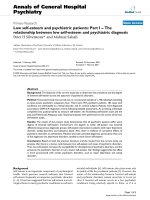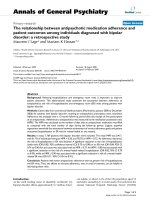The dynamic relationship between commercial real estate and stock markets
Bạn đang xem bản rút gọn của tài liệu. Xem và tải ngay bản đầy đủ của tài liệu tại đây (1.41 MB, 259 trang )
THE DYNAMIC RELATIONSHIP
BETWEEN COMMERCIAL REAL ESTATE AND STOCK MARKETS
YANG HAISHAN
(B.Eng. (Hons), M.Sc., Chongqing)
A THESIS SUBMITTED
FOR THE DEGREE OF DOCTOR OF PHILOSOPHY
DEPARTMENT OF REAL ESTATE
SCHOOL OF DESIGN AND ENVIRONMENT
NATIONAL UNIVERSITY OF SINGAPORE
2003
i
ACKNOWLEDGEMENTS
I appreciate the dedication of the many individuals who helped me to complete this
dissertation. First and most foremost, I like to express my deepest gratitude to my
academic advisor, Professor Liow Kim Hiang, for his tremendous guidance,
encouragement, and extraordinary support throughout the whole process of this
dissertation.
I am also grateful to the rest of my dissertation committee, Dr. Joseph Ooi Thian
Leong and Dr. Lum Sau Kim for their thoughtful input and guidance during the
process of completing this dissertation. In addition to my dissertation committee, I owe
many thanks to Dr. Tu Yong, who provided me the prompt feedback through emails
and calls. I am also grateful to Dr. Zhang Xibin for his support as a good friend and as
a mentor.
Moreover, I wish to extend to profound appreciation to my parents who have taught
me the importance of education and who have devoted their lives to supporting their
children. Finally, and most importantly, I am indebted to my girlfriend, Miss Sun
Yang. Without her constant encouragement, unceasing sacrifices, and emotional
support, the completion of this dissertation could not have been possible.
ii
To my family, in gratitude for their confidence and patience—I relied on both when
my own wavered, and to the memory of my beloved mother whose influence on my
life has become clearer since she was called home to be with the Lord during my Ph.D.
study.
iii
TABLE OF CONTENTS
LIST OF TABLES
LIST OF FIGURES
CHAPTER 1 INTRODUCTION
1.1 Background 1
1.2 Research Objectives 14
1.3 Research Questions 14
1.4 Significance of the Research 15
1.5 Research Data 17
1.6 Research Framework and Methodology - Commercial Real
Estate Market, Stock Market, and Macroeconomy 18
1.7 Empirical Research Framework and Methodology 26
1.8 Scope of the Research 30
1.9 Outline of the Research 31
CHAPTER 2 LITERATURE REVIEW
2.1 Introduction 35
2.2 Relationships between Direct and Indirect Real Estate 35
2.2.1 Presence of a Pure Real Estate Factor in Indirect Real Estate 36
2.2.2 Causal Relationship Between Direct and Indirect Real Estate 43
2.2.3 Long-run Relationship Between Direct and Indirect Real Estate 50
2.3 Relationships between Real Estate and Stock Markets 53
2.3.1 Cross-correlation Analysis 54
2.3.2 Market Integration/Segmentation Analysis 55
2.3.3 Causal Relationship Analysis 60
2.3.4 Measurement Issues in Real Estate Return and Risk 62
2.4 The Macroeconomic Factors Influencing Real Estate and Stock Markets 65
2.4.1 Stock and the Macroeconomy 66
2.4.2 Real Estate and the Macroeconomy 72
2.5 Conclusion 75
iv
CHAPTER 3 MARKET STRUCTURE AND HISTORICAL REVIEW
3.1 Introduction 80
3.2 Overview of Singapore 80
3.3 The Singapore Commercial Real Estate Market 82
3.4 The Singapore Stock Market 88
3.5 Listed Property Companies in Singapore 90
3.6 Review of the Market Performance 95
3.7 Review of Related Singapore Property Research –
Commercial Real Estate and Property Companies 104
3.8 Concluding Remark 105
CHAPTER 4 UNIVARIATE LINEAR AND NONLINEAR ANALYSIS
4.1 Introduction 107
4.2 Descriptive Statistics 107
4.3 Univariate Linear Analysis 112
4.4 Univariate Nonlinear Analysis 116
4.5 Summary 121
CHAPTER 5 MARKET INTEGRATION BETWEEN COMMERCIAL REAL
ESTATE AND STOCK MARKETS
5.1 Introduction 124
5.2 Research Scope and Hypotheses 125
5.3 Research Data 126
5.3.1 Office Price Index (PPIO) 126
5.3.2 Stock Market Index (SGXA) 127
5.3.3 Data Treatment for Synchronization 130
5.4 Research Methodology 130
5.4.1 Unit Root Test 133
5.4.2 Engle-Granger’s Cointegration Technique 140
5.4.3 Johansen Cointegration Technique 141
5.4.4 Fractional Cointegration Technique 143
v
5.5 Results and Discussion 151
5.5.1 Results of Unit Root Test 151
5.5.2 Results of Cointegration Analysis 153
5.6 Summary 162
CHAPTER 6 CAUSAL RELATIONSHIP BETWEEN COMMERCIAL
REAL ESTATE AND STOCK MARKETS
6.1 Introduction 165
6.2 Research Scope and Hypotheses 165
6.3 Research Data 167
6.4 Research Methodology 167
6.4.1 A Testing Procedure for Linear Granger Causality 167
6.4.2 A Testing Procedure for Nonlinear Granger Causality 169
6
.4.2.1 Modified Baek and Brock Nonparametric Method 169
6.4.2.2 Bivariate Fractionally Integrated Error Correction Model 173
6.5 Results and Discussion 175
6.5.1 Results of Linear Granger Causality Tests 175
6.5.2 Results of Nonlinear Granger Causality Tests 178
6.6 Summary 183
CHAPTER 7 RELATIONSHIP BETWEEN COMMERCIAL REAL
ESTATE AND STOCK MARKETS IN THE
MACROECONOMY
7.1 Introduction 186
7.2 Research Scope and Hypotheses 187
7.3 Research Data 191
7.3.1 Gross Domestic Product 192
7.3.2 Interest Rate 193
7.3.3 Inflation 194
7.3.4 Exchange Rate 194
7.3.5 Data Treatment for Synchronization 194
7.4 Research Methodology 195
7.4.1 Cointegration Analysis 196
7.4.2 Vector Error Correction Model and Fractionally
Integrated Error Correction Model 198
vi
7.5 Results and Discussion 200
7.5.1 Long-run Relationship in a Macroeconomic Setting 200
7.5.1.1 Results of Linear Cointegration Analysis 202
7.5.1.2 Results of Fractional Cointegration Analysis 208
7.5.2 Short-run Dynamics in a Macroeconomic Setting 210
7.5.2.1 Results of Vector Error Correction Model 210
7.5.2.2 Results of Fractionally Integrated Error Correction Model 213
7.5.3 Forecasting Performance 217
7.6 Summary 218
CHAPTER 8 CONCLUSION
8.1 Summary of Major Findings 222
8.2 Implication for Real Estate Investment 227
8.3 Research Contributions 229
8.4 Limitations of the Research 230
8.5 Recommendations for Further Study 231
BIBLIOGRAPHY
vii
SUMMARY
This thesis explores three major issues regarding dynamic relationship between
commercial real estate and common stock markets: market integration, causal
relationship, and long-run and short-run relations in the macroeconomic setting.
Various linear and nonlinear, parametric and nonparametric testing methodologies are
applied to a Singapore data set over the 1975-2001 period in an integrated procedure.
Before the relationship between the two markets is examined, we provide a
comprehensive description of the distributional traits for each of the series throughout
this dissertation. In general, certain degree of nonlinear structure, other than linear
fabric, is present in commercial real estate and some macroeconomic variables. Thus,
existing linear models would need to be enhanced to ensure that these nonlinear
structures are accounted for in order to uncover the complex interrelation between
commercial real estate and stock markets.
The dynamic relationship between commercial real estate and stock markets is then
addressed in three ways. First, we examine integration/segmentation between the two
markets. While evidence of a long-run relationship for the two asset classes is found
with Johansen cointegration tests, the standard residual-based cointegration techniques
fail to provide any similar evidence. We attribute the inconsistencies between the
cointegration results to the possibility of fractional cointegration which allows for
fractionally integrated equilibrium errors and thus encompasses a wide range of mean-
reversion behavior. Based on the parametric Geweke-Porter-Hudak (GPH) test, the
empirical results do show that the equilibrium errors could be characterized by the
fractionally integrated processes. Therefore, the commercial real estate market is
viii
nonlinearly related to the stock market, but the mean reversion between the two
markets is quite slow.
Second, we consider linear and nonlinear causal relationships between the two
markets. In a linear Granger causality framework, the error-correction augmented
VAR model shows that the commercial real estate market seems to informationally
lead the stock market. The results imply that the private real estate market contains
information that can be impounded in the securitized market through insider trading.
However, the nonlinear Granger causality test based on the fractional cointegration
indicates a significant bi-directional nonlinear causal relationship between the two
markets. The strong evidence of the feedback effect is consistent with the fractional
cointegration results and provides support for the prior finding that the commercial real
estate market does have an influence on the stock market, rather than simply acting as
a secondary absorber of information flow.
Third, we examine the long-run and short-run relations between the two markets
within the economic system including GDP, interest rate, inflation and exchange rate.
If both corporate profits and rents were driven by economic fundamentals, then
commercial real estate and stock prices should be expected to move together within the
macroeconomic framework. The results show that the two markets are linearly in long-
run equilibrium within the economic system, and that after controlling for changes in
the macroeconomy, the observed positive relation between the two markets weakens.
This implied that the correlation between the two markets is mainly due to their
common reactions to fundamental economic activities. In addition, the results indicate
the presence of nonlinear fractional cointegration among commercial real estate, stock
ix
and key macroeconomic factors. In the short-term dynamics, the macroeconomic
variables are found to exert stronger influence on the commercial real estate market
than the general stock market. Hence the commercial real estate market is significantly
related to the key macroeconomic factors. To unveil the implication of the nature of
long-run relation for the short-term dynamics, we further investigate the forecasting
performance of the fractionally integrated error correction model (FIECM) against the
conventional vector error correction model (VECM) for the prediction of the
commercial real estate price index. Consistent with our expectation, incorporating
fractional cointegration (if present) in an ECM does improve forecasting performance
over the traditional ECMs.
We do not intend to uncover the whole spectrum of the three selected issues in making
inferences about the dynamic interactions between the commercial real estate and the
common stock markets. Within the sphere of mixed-asset allocation and corporate real
estate management, the methods and evidence reported in this research can form the
basis for further study in empirical literature related to the synthesis of modern
economic and finance theories with real estate investment and management in the
context of increasing interactions between real estate and broader capital markets.
x
LIST OF TABLES
1.1 Advantage and Disadvantage of Direct and Indirect Real Estate
Investment 11
1.2 Overview of Research Data Requirements 17
2.1 Summary of Studies on the Presence of a Pure Real Estate
Factor in Indirect Real Estate 37-38
2.2 Summary of Studies on the Lead-lag Relationship Between the
Direct and the Indirect Real Estate Markets 45-46
2.3 Summary of Studies on the Long-run Relationship Between the
Direct and Indirect Real Estate Markets 52
2.4 Summary of Studies on the Integration between Real Estate and
Stock Markets with Asset-pricing Framework 57
2.5 Summary of Studies on the Integration between Real Estate and
Stock Markets by Modeling the Relations Between Asset Prices 59
2.6 Summary of Studies on the Relationships Between Stock
Market and Macroeconomic Variables 69-70
2.7 Summary of Studies on the Relationships Between Real Estate
Market and Macroeconomic Variables 73
3.1 Singapore Economic and Financial Indictors: 2001 82
3.2 Ownership of the Major Office Buildings in the CBD Area 87
3.3 Market Capitalizations of the Top 15 SGX Mainboard Companies
and the Contribution to the Market at the End of 2001 89
3.4 Market Capitalizations of Various Sectors in SGXA at the End
of 2001 90
3.5 Listed Property Companies in Singapore (End of 2001) 92-94
3.6 Inter-asset Correlation Matrix and Return-risk Performances
of the Commercial Real Estate and Stock Markets: 1975-2001 96
4.1 Characteristics of Series 108
4.2 Descriptive Statistics of Series (1980:1-2001:4) 111
4.3 ADF and PP Test for Presence of Unit Root (1980:1-2001:4) 113
xi
4.4 Estimation Results of the ARIMA Models 115
4.5 Post-sample Forecasting Performances of the Office Price Index 116
4.6 Results of Rescaled Range Analysis 120
4.7 Results of BDS Analysis 121
5.1 Sectorial Reclassification of Companies Listed on the SGX 128
5.2 Mainboard Listed Companies Related to the Property Sector 129
5.3 Empirical Size of the GPH Test for Cointegration 150
5.4 Descriptive Statistics of the PPIO and SGXA 152
5.5 Perron Unit Root Test on Individual Indices for Known
Breakpoints 153
5.6 Results of the ADF Test for Cointegration 154
5.7 Testing for Appropriate Lag-length in Johansen Cointegration 155
5.8 Results of Johansen Cointegration Test for Market Integration 156
5.9 Results of the GPH Test for Cointegration between Office
and Stock 160
5.10 Summary of Results of Linear and Nonlinear Cointegration Test 162
6.1 Results of Linear Granger Causality 176
6.2 Results of Linear Granger Causality in Different Sub-periods 178
6.3 Results of Modified Baek and Brock Test 180
6.4 Results of Bivariate FIECM Nonlinear Granger Causality Test 182
6.5 Summary of Results of Linear and Nonlinear Granger Causality
Tests (1975:1 –2001:4) 183
7.1 Comparison of New and Old Format for Presenting GDP
by Industry 193
7.2 Synchronization Treatment for Macroeconomic Variables 195
7.3 Descriptive Statistics of Four Macroeconomic Variables 201
7.4 Unit Root Tests of Macroeconomic Variables 202
xii
7.5 Testing for Appropriate Lag-length for Relation in Economic
System 202
7.6 Results and Critical Values for the λ
max
and λ
trace
Test for
Relation in an Economic System 203
7.7 Results of Johansen Cointegration Test in a Bivariate System
(1980:1-1998:4) 207
7.8 Estimation Results of the ARFIMA (0, d, 1) Models 209
7.9 VECM Results for Commercial Real Estate, Stock and
Macroeconomic Variables 211
7.10 FIECM Results for Commercial Real Estate, Stock and
Macroeconomic Variables 214
7.11 Summary Table of Main Features of VECM and FIECM
Results 216
7.12 Comparison of Post-sample Forecasts of the Office Price Index 218
xiii
LIST OF FIGURES
1.1 Distribution of Commercial Real Estate Space in Singapore 12
1.2 Distribution of Commercial Real Estate Capital Value in
Singapore 12
1.3 Commercial Property Market, Stock Market and Macroeconomy:
Theoretical Framework 20
1.4 Empirical Research Framework 27
3.1 Office Space Cumulative Supply and Occupancy Rates 83
3.2 Retail Space Cumulative Supply and Occupancy Rates 83
3.3 Geographic Distribution of Existing Office Stock 84
3.4 Price Movements of Commercial Real Estate and Stock Markets 97
3.5 Movements of the Macroeconomic Variables 98
3.6 Index Returns of Commercial Real Estate and Stock Markets 98
4.1 Singapore Office and Stock Price Indices (1980:1-2001:4) 109
4.2 Index Returns of Singapore Office and Stock Markets (1980:1-
2001:4) 109
5.1 Correlogram of the LSGXA and DLSGXA, LPPIO-LSGXA
Cointegrating Vector (1975:1 – 2001:4) 158
5.2 Correlogram of the LSGXA and DLSGXA, LPPIO-LSGXA
Cointegrating Vector (1975:1 – 1987:3) 158
5.3 Correlogram of the LSGXA and DLSGXA, LPPIO-LSGXA
Cointegrating Vector (1987:4 – 1996:1) 159
7.1 Differenced Logarithms of Macroeconomic Variables 201
7.2 Autocorrelation Function of the Equilibrium Error of
Relationship in Economic System 209
1
CHAPTER 1 INTRODUCTION
1.1 Background
1.2 Research Objectives
1.3 Research Questions
1.4 Significance of the Research
1.5 Research Data
1.6 Theoretical Framework
1.7 Empirical Research Framework and Methodology
1.8 Scope of the Research
1.9 Outline of the Research
Chapter 1 Introduction
2
CHAPTER 1 INTRODUCTION
1.1 Background
Commercial real estate is an important asset in the economy. It is different from other
resources used by companies, and the relevant market also differs in many ways from other
types of markets (Weimer, 1966). Commercial real estate is not only a factor of production but
also an important investment. A distinction is thus made in commercial real estate ownership
between use decisions versus investment decisions. At the basic level, commercial real estate
is an economic generator and contributor. It serves the need of contemporary businesses,
institutions, and individuals for an enclosed space in which their business activities are
conducted (Roddewig, 1993). On the other hand, investors, regarding it as a capital asset, also
drive the demand for commercial real estate space. The dual functions of commercial real
estate thus suggest that there are two distinct but interrelated real estate markets: the market for
tenant space (space market) and the market for investment capital (the asset market)
(Dipasquale and Wheaton, 1992).
The demand for commercial real estate space as a factor of production is linked to the
conditions of the broad economy. The demand for commercial real estate accommodation rests
on business firms’ production decisions. Consequently the demand for commercial real estate
is a derived demand that is driven by the need for goods and services produced using
commercial real estate space. In this way, movement of the commercial real estate market
would be influenced significantly by business firms’ decisions on resource allocation to
commercial real estate space that are mainly based on the current and expected
macroeconomic conditions.
1
Therefore, commercial real estate is linked to the economy, and
1
The terms “real estate” and “property” are used interchangeably in this dissertation.
Chapter 1 Introduction
3
its performance is closely related to, and at least partially accountable by, some of the
macroeconomic activities (Wang, 2001).
Institutional and retail investors have a long history of owning the rights to the rental flows
from commercial real estate ownership as investments. Commercial real estate, as an
investment, has to compete with other assets for a place in investors’ portfolio. Investors view
commercial real estate not only as an asset to earn a competitive risk-adjusted rate of return,
but also as a contributor to multi-asset portfolio performance and total portfolio risk. In fact,
the role of commercial real estate in a mixed-asset portfolio has received considerable attention
with an influx of modern finance theories and techniques into the real estate field since the
1950s (Liow, 1998). With the growing acceptance of commercial real estate by institutional
investors as an important component of a mixed-asset portfolio in the context of growing
interaction between commercial real estate market and financial sectors, especially the stock
market, increasing attention has been focused on the relationship between the commercial real
estate and stock markets.
As an asset, commercial real estate has received renewed attraction from many investment
programs, especially at a time when the high-return boom years fade. In the past decade,
commercial real estate, in the equity side, has developed into an asset class with viable
investment choices in two different forms:
(a) Direct commercial real estate market. This is private investment in individual/joint
ownership of physical commercial buildings such as office or shopping centers. The main
players in the direct real estate market are long-term institutional investors such as pension
funds and insurance companies. For example, about 45% of commercial real estate in the
Chapter 1 Introduction
4
UK is held by “investors’ and nearly half of this is held by institutional investors
(Callender and Key, 1996).
2
(b) Indirect commercial real estate market. This is public investment in ownership of
commercial real estate holdings. Like stock investment, this type of securitized real estate
vehicle enables retail investors to participate in the equity ownership. The form of indirect
equity commercial real estate varies from country to country but comprises two main
classes. The first and most general type of indirect real estate is listed property stock. Some
of these “pure play” property companies are property developers and some are property
investors.
3
Most are involved in a combination of real estate investment, development and
trading activities. The second type of indirect real estate comprises Listed Property Trusts
(LPTs) in Australia
4
or US Real Estate Investment Trusts (REITs)
5
, both of which offer a
share in an unlevered portfolio of real estate.
Over the last decade, the market for indirect equity real estate has grown significantly. In the
US, the capitalization of equity REITs market was only $8.7 billion in 1991. However, the
market capitalization of the REIT industry has increased significantly since 1993 due to the
extraordinary number of initial and secondary public offerings (Block, 1998). According to the
National Association of Real Estate Investment Trusts (NAREIT) Statistics for the year 2002,
approximately $118 billion was raised through initial and secondary public offering of REITs
during the period 1993-2002. This trend continued in subsequent years primarily as a result of
2
The terms “private”, “unsecuritized” or “direct” real estate markets are used interchangeably. Also applicable are
the terms “public”, “securitized” or “indirect” real estate markets.
3
Property developers are featured by property acquisition and trading mainly for development profit and property
investors are featured by property acquisition and management aiming at obtaining capital gain and rent in the long
run (Newell and Chau, 1996).
4
Property Trusts also exist in UK. However, they are tradable only with primary issuer and at appraisal-based
prices. As there is no secondary market, such investments tend to have the characteristics of direct real estate (Chau,
MacGergor and Schwann, 2001).
5
Most studies consider equity REITs rather than mortgage REITs. An equity REIT acquires direct interests in real
estate while a mortgage REIT purchases mortgage obligations backed by the underlying real estate (Chau,
MacGergor and Schwann, 2001).
Chapter 1 Introduction
5
the increased institutional demand for REIT stocks. By the end of 2002, publicly traded
REITs’ total size had grown to $151.3 billion. The LPTs in Australia are also significant. From
less than $5 million in the early of 1990s, the sector reached a market capitalization of $45.8
billion by the end of 2002 (Property Council of Australia).
In Singapore, listed property stock dominates the indirect real estate investment while equity
REITs as an investment tool only emerged from 2002. Over the past ten years or so, the
growth in the indirect real estate market (listed property stock) has been impressive. The
capitalization of securitized property sector has increased from S$1.99 billion at the end of
1986 to S$19.4 billion at the end of year 2001.
6
Some of the listed property companies are
primarily investment oriented and others are involved in a combination of real estate
investment, development and trading locally and regionally.
7
As for the REITs market, the
first retail-based REIT (Capital Mall Trust) issued by a local property heavyweight CapitaLand
was launched in July 2002 and the first industrial REIT (A-REIT) was launched by Ascendas
Land in October 2002. Capital Mall Trust owns three major shopping malls in Singapore while
A-REIT owns eight industrial properties. Both REITs will make
distributions to unit holders
out of rental income from these properties. Another local property developer, Keppel Land, has
also expressed interests in launching the first office-based REIT
.
Besides Singapore, REIT/LPT market in developed countries has seen its other Asian
followers, mainly in Japan, Korea and Malaysia. Two REITs in Japan (J-REITs) was listed in
the Tokyo Stock Exchange in 2001. Both J-REITs raised a combined 130 billion yen (US$1.05
billion) from the capital market (Ting, 2002). Over the long term, Nikko Salomon Smith
6
The total size of property counter in Singapore covers the property companies incorporated and listed on SGX
mainboard and traded in S$, which is in line with the criteria of SGX for property companies eligible to be included in
the overall property stock price index, SGX All Property Index. Furthermore, the market size for preferential shares is
excluded.
7
Some key examples of Singapore property companies are City Development, CapitaLand and KeppeLand.
Chapter 1 Introduction
6
Barney Ltd estimates the J-REITs market will grow to 5 trillion yen (US$40 billion) in assets
with an equity capitalization of 3 trillion yen (US$24 billion).
Two types of RETIs were introduced in Korea, Corporate Restructuring REITs (CR-REITs)
and Ordinary REITs (O-REITs). CR-REITs are devised for companies to dispose of real estate
for the purpose of corporate restructuring, whereas O-REITs are normal type of REITs which
would invest in properties and distribute their income to investors. The popularity of the two
types of REITs in Korea varies among the institutional investors. While CR-REITs have been
well-received among the corporate community with about five consortiums having concluded
Memorandums of Understanding to set up CR-REITs, the O-REITs have not been set up as
expected. Malaysia was the first Asian country in developing LPTs in 1989. Currently, 4
property trusts are listed on the Kuala Lumpur Stock Exchange. Three of them were listed in
1989, and the fourth listed in 1997. The listed property trusts mainly focused on office
properties in Kuala Lumpur. Unlike the US and Australia, these property trusts are also able to
cover significant levels of stocks and short-term investments in their total portfolios, with the
level of non-real estate in the portfolio being as high as 40% in recent years (Newell et al,
2002).
Given that the real estate-related business builds blocks of the principal activities of securitized
real estate, it is expected that the performance of the secutitized real estate be related to the
performance of the underlying real estate market. The linkage between the two markets from
previous studies can be summarized as follows:
8
a) Both securitized real estate and its underlying real estate market share a common
component reflecting real estate fundamental;
8
More details about the relationships between the securitized and unsecuritized real estate markets are available in
the Chapter Two.
Chapter 1 Introduction
7
b) Securitized real estate performance leads the underlying real estate performance;
c) There is a long-term equilibrium relationship between securitized real estate and
its underlying real estate market in the context of macroeconomy;
d) Both securitized and its underlying real estate markets may be closely integrated
with other asset markets.
However, indirect real estate, given its rapid development, is still small relative to its direct
counterpart (at least) in dollar value. In the US, where the indirect real estate market, i.e., the
REIT market, has grown very fast in the past ten years, it still takes a small share in the pool of
the commercial real estate. The universe of commercial real estate in the US was estimated to
be worth $4.3 trillion in 2000 and accounted for approximately 10% of the total US investment
market (Conner, Hess and Liang, 2001), whereas the NAREIT index (Equity) had a total
market capitalization of about 3% of the total value of commercial real estate or $134 billion at
the end of 2000 (www.nareit.com).
9
In Singapore, as of the fourth quarter of 2001, using Jones
Lang LaSalle (JLL)’s capital values and the Urban Redevelopment Authority’s (URA)
10
published stock of commercial real estate in different areas across the island, the capital value
of the entire commercial real estate domain in Singapore, i.e., office buildings and shopping
centers, was conservatively estimated to be worth about S$81 billion while the market size of
the SGX All Property Index was S$19.4 billion at the end of same year. This was less than
25% of the whole commercial real estate realm. In South East Asia, approximately 11% of all
institutional grade real estate is listed. The public market real estate penetration in the global
9
In the US, REITs are classified into three sub-sectors based on investment types: equity REITs, mortgage REITs
and hybrid REITs. Usually equity REITs take the biggest share of total REITs market in terms of market
capitalization. Equity REITs account for 97.1% of US$138 billion of total REITs universe near the end of 2000.
10
The URA is responsible for the strategic and physical planning of the country so as to optimally use Singapore
scarce land resources. It formulates and reviews concept plans, conducts local planning and administers the
development control and urban conservation functions to regulate private and public sector’s property development
proposals.
Chapter 1 Introduction
8
context hovered around 12% in 2000 with Australia being the bellwether (55%) followed by
North America (18%) and the UK (17%) (Steinert and Crowe, 2001). The ratio of indirect to
direct commercial real estate in terms of capital value would be even smaller if we consider
that the share of indirect commercial real estate may represent a minor part in the total value of
indirect real estate market.
11
Even on very optimistic assumptions in respect of the public
equity real estate market’s growth, direct ownership of commercial real estate will dominate
the total commercial real estate pie in the foreseeable future (McIntosh and Liang, 1998).
In addition to the relative size of direct and indirect real estate, differences in the
characteristics of the two real estate investment vehicles in a mixed-asset portfolio further
justify that direct real estate can contribute in the core real estate investment as an effective
diversification tool. For example, Craft (2001) recommends allocations to real estate of
between 6% and 10% when including public real estate and 12% when considering private real
estate. In an asset/liability framework, Chun, Ciochetti and Shilling (2000) conclude that
private real estate allocations should be between 12% to 16% and public real estate between
4% and 10%. Furthermore, research on “Real Estate in the Investment Portfolio of a Pension
Fund” carried out by ING Investment Management in 1998 found that in general, direct real
estate has added value for the total investment portfolio of a pension fund while the indirect
real estate has no added value for the portfolio. Along this line, direct real estate should form
the core real estate investment holdings while a minority investment in indirect real estate
could be added to core direct real estate investments for tactical asset allocation purposes and
to increase overall liquidity (Spek and Doorn-Gröniger, 2001).
In general, institutional investors’ strategic investment portfolios comprise stock, fixed income
11
Under equity REITs, there are further classifications based on the predominant type of assets, including office,
retail, residential, industrial, hotel, healthcare and diversified. In Singapore, the listed property companies
invest/develop various property types covering office, retail, residential and industrial. Most of them do not clearly
report the composition of their property portfolios in value terms.
Chapter 1 Introduction
9
securities (bonds and treasure bills) and real estate.
12
In the real estate investment arena,
private or direct ownership makes up a dominating proportion. For example, the ten largest
Dutch pension funds invested, on average, 74% in direct real estate and 26% in indirect real
estate in their real estate portfolios at the end of 2000 (Spek and Doorn-Gröniger, 2001).
13
Despite its obvious significance as a key economic generator in the economy and as an
important component in the mixed-asset portfolio, direct commercial real estate is less
understood than stock and fixed income securities, especially where its relationship with other
two asset markets is concerned. While sporadic studies appeared in exploring the relationship
between the commercial real estate and stock markets by using securitized real estate as a
proxy for the real estate market, the point is that there is inadequate evidence to support the
belief that the indirect real estate market should necessarily behave in a similar manner as the
underlying direct real estate market (Wang, 2001). The differences between the characteristics
of underlying direct real estate and indirect real estate investments can be briefly summarized
as follows:
a) The indirect real estate is a financial claim traded on stock exchange, which introduces
some features of general stock market not present in the underlying direct real estate
market. In this sense, indirect real estate might not be viewed as an investment vehicle
for pure real estate but as “hybrid financial assets that embody the economic
characteristics of the underlying real estate market coupled with the volatility of the
stock market” (Corgel, 1995).
b) The indirect real estate only represents a small portion of total real estate assets, both
12
Treasure bill (T-bill), usually in 3-month period, is termed as “cash” in investment community.
13
The relative levels of direct and indirect real estate property in institutional investors may vary from the market
with high public market real estate penetration to that with low public market real estate penetration, and could
change over time. For example, the ratio of private/public real estate investment of Intech, an managed fund in
Australia which has the highest public market real estate penetration in 2000 (55%), varied from 1/3 in 1986 to
1/1.12 in 1995 to 1/3.25 in its real estate portfolios estate at the end of 2000 (Armytage, 2002). The public market
real estate penetration in Continental Europe in 2000 stood at 3% (Steinert and Crowe, 2001).
Chapter 1 Introduction
10
in terms of space and dollar value, whereas the rest is dominated by direct real estate.
This situation would prevail in the foreseeable future.
c) Besides the fundamentals in real estate market, the advisory and ownership structure,
company management, accounting policies and taxation are all reflected in the
performance of indirect real estate as well (Bradley, Capozza and Seguin, 1998;
Friday, Sirmans and Conover, 1999; Capozza and Seguin, 2000). Furthermore, the
indirect real estate is always geared. All of them would result in a big variation from
the underlying direct real estate in terms of the performance.
d) Some indirect real estate vehicles such as listed property companies are not “pure
players” in commercial real estate. They make diversifications to include residential
property and (or) hotel, even non-property business to some extent.
Table 1.1 below summarizes the advantage and disadvantage of direct and indirect real estate
investment.
Chapter 1 Introduction
11
Table 1.1
Advantage and Disadvantage of Direct and Indirect Real Estate Investment
Direct Real Estate Indirect Real Estate
Liquidity
Illiquid
• great barriers to enter & exit
Liquid
• few barriers to enter & exit
Accessibility
Not accessible to retail
investors but the institutional
investors due to large sums
involved
Accessible to both institutional and retail
investors due to small sums involved
Extent of real estate
exposure
High
• pure real estate exposure with
fundamentals in real estate
market reflected in the
performance
Low
• hybrid features of direct real estate and
stock investments
• besides real estate fundamentals, the
advisory, ownership structure, company
management, etc, are all reflected in the
performance
• diversification to non-property business
Availability &
reliability of info
Low
• no central trading area
High
• presence of central trading area
Management
intensiveness
High
• both investment & operations
oriented
Low
• investment oriented
Investment terms &
duration of investment
performance
measurement
Long Medium & short
Source: Author’s compilation
Of the direct commercial real estate, the office market is very important. For one thing, office
space is essential and closely linked to the operation of modern businesses. Hence it can be
reasonably expected to be pro-cyclical with the whole economy. In the long run, the growth of
office space seems to move reasonably in tandem with the growth of office employment which
largely depends on the economic structure and economic performance (Dipasquale and
Wheaton, 1996). For another thing, office buildings constitute a significant share of the
commercial real estate in terms of capital value and probably represent the best type of real
estate to own in the long term for the institutional investors (Steele and Barry, 1993).
In particular, the office market in Singapore is quite significant. Singapore is one of the Asia’s
leading regional financial centers. The financial sector, together with the insurance and
business service sectors, are traditionally one of the economic drivers and the major users of

